Barbara Kyle's Blog: The Rest of the Story - Posts Tagged "elizabeth-i"
Giveaway!

I'm delighted to kick off this new blog with a giveaway of my Elizabethan thriller, The Queen's Exiles.
My publisher is giving away 25 advance copies here at Goodreads! Here's the link:
https://www.goodreads.com/giveaway/sh...
Advance praise for The Queen's Exiles:
“This moving adventure pulses with Shakespearean passions: love and heartbreak, risk and valour, and loyalties challenged in a savage time.” – Antoni Cimolino, Artistic Director of the Stratford Festival
“A firecracker of a romantic thriller.” – Jenny Barden, author of The Lost Duchess
“Brilliant…a page-turner of love and loyalty in treacherous Tudor times. In the footsteps of her intelligent, courageous heroine, Barbara Kyle sweeps us from the salty boatyards of Sark to the sumptuous courts of Europe on a truly unforgettable adventure.” – Deborah Swift, author of A Divided Inheritance
“A vivid and compelling novel brimming with wonderful characters. An exquisitely crafted escape to another place and time by an author at the very top of her craft.” – Diane Haeger, author of I, Jane
"Barbara Kyle owes me two nights of sleep for writing such an enthralling book that I couldn't stop turning the pages until the final mesmerizing sentence." - Christine Trent, Author of Stolen Remains
Enter the Goodreads giveaway to win an advance copy!

Published on January 17, 2014 06:28
•
Tags:
elizabeth-i, giveaway, historical-fiction, historical-thriller
2 Days Left to Enter the Giveaway!
Win an advance copy of my new historical thriller THE QUEEN'S EXILES.
My publisher is giving away 25 ARCs here at Goodreads. There are still 2 days left to enter.
https://www.goodreads.com/giveaway/sh...
This giveaway ends on February 17th.
I hope you win one!
My publisher is giving away 25 ARCs here at Goodreads. There are still 2 days left to enter.
https://www.goodreads.com/giveaway/sh...
This giveaway ends on February 17th.
I hope you win one!
Published on February 14, 2014 07:26
•
Tags:
elizabeth-i, giveaway, historical-fiction, historical-thriller
The Three-Armed Woman: Book Covers to Love
 We'll get to the three-armed woman in a minute.
We'll get to the three-armed woman in a minute.First, I'm happy to tell my readers in the UK that The Queen's Gamble (left) is now available in the UK.
The Queen's Gamble was released in the US and Canada first in 2011 with a different cover (below).
It was an Editor's Choice of the Historical Novels Review: http://historicalnovelsociety.org/rev...
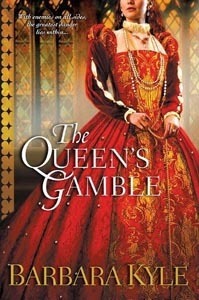
The two covers - UK edition (green) and US edition (orange) - are very different. Publishers use cover art that they feel will appeal to readers in their respective countries.
For example, look at how differently three of my publishers saw The King's Daughter. The top one is the US/Canada cover, the middle one is the UK cover, the bottom one is the Portuguese cover:
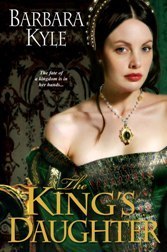
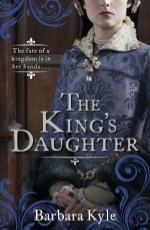

So where, you ask, is the "three-armed woman" of the title of this blog post? Well, she's on the famous cover of a book by bestselling romance author Christina Dodd - famous because it was a big oops!
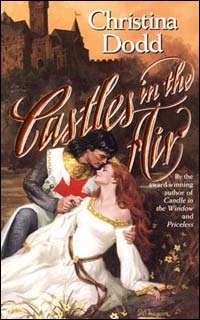
Can you spot the lady's three arms? 1) She's leaning on her left hand, 2) The knight is holding her right hand, 3) Bingo: #3 is beside her right knee!
The author, Christina Dodd, wrote a hilarious article about her adventure with this cover blooper. To read it click here: http://christinadodd.com/christina-do...
There are some stunningly awful covers for various editions of the classic Jane Eyre. Here's one:
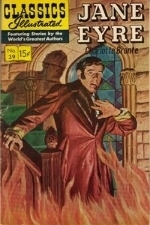
For a smile, see more "bad Jane Eyre covers" here: http://bizarrevictoria.livejournal.co...
I'm delighted with the cover of my upcoming historical thriller The Queen's Exiles on which my heroine, Scottish-born Fenella Doorn, has the standard-issue two arms. I hope you like it!
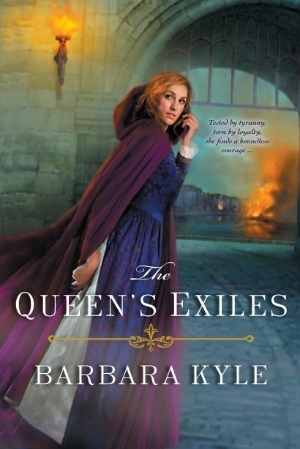
The Queen's Exiles will be released 27 May 2014. You can pre-order it now and receive it the day it's released. To pre-order from Amazon click here: http://tinyurl.com/nozlppk
Happy reading, whatever the cover!
Published on March 07, 2014 07:43
•
Tags:
elizabeth-i, historical-fiction, historical-novel, historical-thriller, the-queen-s-gamble, tudors
Did the Queen Murder her Husband?
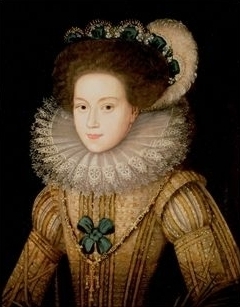
The news stunned Queen Elizabeth I and her court. Her cousin Mary, Queen of Scots had been defeated on the battlefield near Glasgow and fled in terror of being captured. Crossing the border to England she had arrived in Carlisle with nothing but the clothes she stood up in. It was May, 1568.
Mary (that's her on the left) wrote to Elizabeth asking for her support to storm back to Scotland at the head of an army to vanquish her foes. Those foes were led by Mary's half-brother, the Earl of Moray, who just months before had forced her (at knife point, she said) to abdicate. He had also accused her of adultery with the Earl of Bothwell and of conspiring with him to murder her husband, Lord Darnley.
Welcome to the shark-infested world of 16th-century Scottish politics.
Darnley had indeed been murdered the year previously when the house he was staying in near Edinburgh was blown up. It had been undermined with kegs of gunpowder. Charges for masterminding the crime were laid against Bothwell, the tough military man Mary had turned to when her marriage had soured. There had been plenty of gossip that she and Bothwell were lovers. At his trial Bothwell was acquitted, thanks to Mary's support, and three months after Darnley's death she took Bothwell as her husband.
Moray and his followers then accused Mary herself of the murder. They imprisoned her and forced her to abdicate. Mary had lost her kingdom. Bothwell fled to Denmark.
But Mary escaped, raised an army, and met Moray on the Glasgow battlefield. He won. Mary had lost her kingdom for the second time. She was twenty-six.
Arriving in England as a royal refugee, Mary fully expected her cousin Elizabeth's protection and support. Mary was often blind to reality when she had a passionate stake in a situation, and never was she more blind than when she asked for help from Elizabeth. (That's Elizabeth below.)
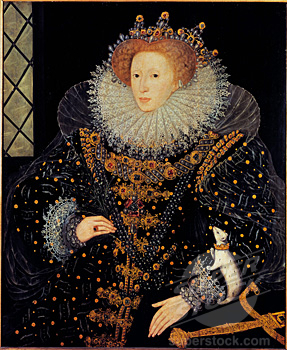
Because Mary's arrival in England created a terrible quandary for Elizabeth. England was Protestant but a large, disgruntled portion of its people were Catholics who believed that Mary, a pious Catholic, should be on the throne instead of Elizabeth, whom they regarded as illegitimate and a heretic. Both queens had Tudor blood. Elizabeth was the granddaughter of the first Tudor monarch, Henry VII; Mary was his great-granddaughter. Elizabeth, unmarried, had no children (she was thirty-five), and Mary had the best claim to succeed her. Elizabeth feared that Mary would be a lightning rod for these disaffected Catholics to rise up to put her on the throne. Mary could expect the backing, too, of the mightiest power in Europe, Catholic Spain.
Elizabeth's councilors were appalled at the thought of Mary moving freely in England to draw Catholics to her cause, and they advised Elizabeth to imprison Mary. Elizabeth recoiled at that, for she took very seriously her cousin's royal status. However, she decided on a way to neutralize Mary. She could not lend her support, even to a queen, if Mary proved to be an adulteress and a murderer. Here's the dead Lord Darnley.
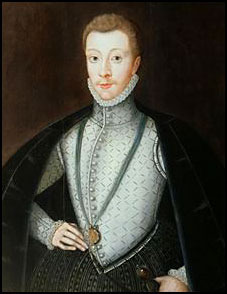
The solution was Machiavellian - and pure Elizabeth. She decided to hold an inquiry into the charges against Mary. In soothing letters to her cousin she assured her that if the charges proved unfounded, as Mary claimed, Elizabeth would wholeheartedly back her in restoring her to her Scottish throne. All of Europe was agog, waiting for the outcome. Elizabeth's tactic was one that modern-day crafters of smear campaigns would appreciate. Dirt, once it is hurled in public, tends to stick. Elizabeth would then be free to uphold her alliance with Moray's Protestant government in Scotland.
It was not called a trial, since English courts had no jurisdiction over foreign rulers, but for all intents and purposes a trial is what it was. Elizabeth set the venue; the inquiry would take place at York. (It would later move to Westminster.) She invited the Earl of Moray to come and argue his case before her commissioners. He eagerly agreed, and set out from Edinburgh with a rookery of lawyers.
Mary was furious. She refused to attend the inquiry, saying that the only way she would appear to answer the charges made by her subjects was if they were brought before her in chains. It was one of her many impetuous decisions that doomed her, for by all accounts she had extraordinary charm and had she attended she might very possibly have won the commissioners' sympathy. Instead, she appointed others to act in her name: Lord Herries and the Bishop of Ross, men staunchly loyal to her.
Elizabeth appointed the Duke of Norfolk to preside. But Norfolk, like just about everyone involved in this intricate piece of political theater, had a hidden agenda. Mary, ever seeking to enhance her power base in England, had made Norfolk an offer he could not resist: marriage. Secretly, in letters, the two formed a marriage plan. For Norfolk it was the brass ring, because Mary had the best claim to be Elizabeth's heir, and if she came to the throne then he, as her husband, would be king. Norfolk, therefore, was secretly predisposed to find Mary innocent.
But then something happened that changed the course of the proceedings, and of history. Moray presented evidence to the English commissioners: eight letters written by Mary to Bothwell while she was married to Darnley. These have become known as the "casket letters," so named because, said Moray, they were found in a small silver casket under a bed in Bothwell's house after he had fled the country.
How convenient, Mary raged. She had good reason to rage, for she only heard about the letters from leaks. Moray had presented them to Elizabeth's commissioners alone, in secret. Mary was not allowed to see the evidence that was to damn her.
And damning it was. The letters were lascivious, the intimate words of a woman to her lover. Worse, they indicated that Mary and Bothwell had indeed been plotting to kill Darnley. News of the letters, carefully leaked, shocked all of Europe. Here's Bothwell.
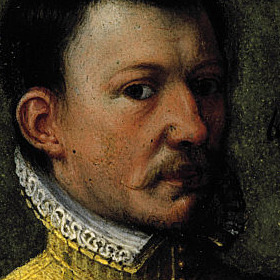
Mary swore to her dying day that the letters were forged. And the fact that she was allowed no rebuttal was such a miscarriage of justice, her furious commissioners withdrew from the inquiry in protest.
Elizabeth gave Mary one last chance to come before the inquiry and defend herself. Mary refused, sure that such a desperate move would be a virtual confession of guilt. But the damage had been done. Mary's reputation was in tatters. Even many of her Catholic followers turned away from her.
Elizabeth was satisfied. She wrapped up the inquiry without even proclaiming a verdict. She didn't have to.
The casket letters no longer exist. Moray took them back to Scotland where they eventually ended up in the possession of Mary's son, James. He became king, and the letters were never seen again.
Mary never regained her freedom. She was kept under house arrest for the next nineteen years. Hers was a comfortable captivity, spent in a series of old castles with a small retinue to serve her, but it was captivity nonetheless. During those nineteen years she plotted ceaselessly to take Elizabeth's crown, and when the last plot in 1586 almost succeeded her complicity was an irrefutable fact. Elizabeth had had enough. Charged with conspiring to murder Elizabeth, Mary's trial took place in October 1586. This time, it was not her reputation that was in jeopardy, it was her life.
That trial was a mere formality, its outcome never in question. Four months later Mary was executed, beheaded at Fotheringhay Castle.
The famous rivalry between these two queens has enthralled the world for over four hundred years. It enthralls us still.
___________________________
The "casket letters" inquiry forms the backdrop of my novel Blood Between Queens.
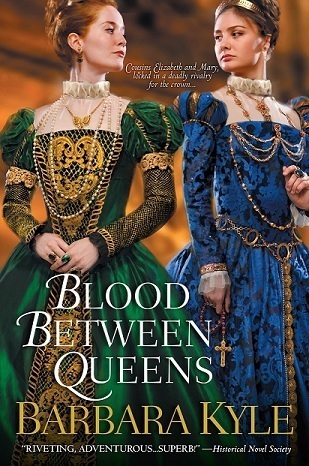
Visit my website www.BarbaraKyle.com
Published on March 13, 2014 18:11
•
Tags:
elizabeth-i, historical-fiction, history, mary-queen-of-scots
The Hinges of History

Game changer. Turning point. We use these terms to describe crucial, pivotal events. In my historical novels I like to call such events the hinges of history.
It's a powerful image: a swinging door. An opening, a closing. Sometimes with a joyful whoosh, sometimes an anxious creak, sometimes a furious slam.
I set my stories at these hinges of history – decisive historical events – to test my characters’ mettle as the doors of change open and close.
My Thornleigh Saga novels follow a middle-class English family's rise through three tumultuous Tudor reigns during which they must make hard choices about loyalty, duty, family, and love.
The Thornleigh family is fictional; I created them. But the dynamic historical events they're passionately involved in are solid, fascinating facts.
 The Thornleigh Saga begins with The Queen’s Lady set in the nerve-jangled court of Henry VIII as he wrenches England away from the Roman Catholic church to divorce Catherine of Aragon and marry Anne Boleyn. Honor Larke and Richard Thornleigh fight to save the church's victims. To get Anne, Henry created a national church - a hinge of history that changed the course of England.
The Thornleigh Saga begins with The Queen’s Lady set in the nerve-jangled court of Henry VIII as he wrenches England away from the Roman Catholic church to divorce Catherine of Aragon and marry Anne Boleyn. Honor Larke and Richard Thornleigh fight to save the church's victims. To get Anne, Henry created a national church - a hinge of history that changed the course of England. When Henry VIII’s bitter daughter, Queen Mary, launches her reign with a vow to annihilate heretics, young Isabel Thornleigh must act quickly to save her family in The King's Daughter. Determined to rescue her father from prison, she entrusts her mission, and herself, to ruthless mercenary Carlos Valverde. But Isabel is also pledged to spy for rebel leader Thomas Wyatt who is bent on overthrowing the Queen. Isabel joins Wyatt's rebellion, a hinge of history that, amazingly, brought the rebel army to the very gates of London.
When Henry VIII’s bitter daughter, Queen Mary, launches her reign with a vow to annihilate heretics, young Isabel Thornleigh must act quickly to save her family in The King's Daughter. Determined to rescue her father from prison, she entrusts her mission, and herself, to ruthless mercenary Carlos Valverde. But Isabel is also pledged to spy for rebel leader Thomas Wyatt who is bent on overthrowing the Queen. Isabel joins Wyatt's rebellion, a hinge of history that, amazingly, brought the rebel army to the very gates of London.  In The Queen’s Captive the hinge of history swings when Henry VIII's daughter, Queen Mary, imprisons her twenty-year-old half-sister Elizabeth in the Tower. The terrified Elizabeth fully expected to be executed. The Thornleighs make it their mission to save her, and in the ensuing national uprising against Mary, Elizabeth learns the hard lessons she will need to become a formidable leader.
In The Queen’s Captive the hinge of history swings when Henry VIII's daughter, Queen Mary, imprisons her twenty-year-old half-sister Elizabeth in the Tower. The terrified Elizabeth fully expected to be executed. The Thornleighs make it their mission to save her, and in the ensuing national uprising against Mary, Elizabeth learns the hard lessons she will need to become a formidable leader.  The Queen’s Gamble is set during the young Queen Elizabeth's fledgling reign. Fearing invasion by the French through Scotland, she sent money to John Knox's Scottish rebels who were fighting their French overlords. Isabel Thornleigh accepts the dangerous mission to secretly take the queen's money to Knox. Eventually, Elizabeth gambled by sending an army north to face the mighty French. Her victory ushered in Knox's Protestant government, swinging a hinge of history that forever changed Scotland.
The Queen’s Gamble is set during the young Queen Elizabeth's fledgling reign. Fearing invasion by the French through Scotland, she sent money to John Knox's Scottish rebels who were fighting their French overlords. Isabel Thornleigh accepts the dangerous mission to secretly take the queen's money to Knox. Eventually, Elizabeth gambled by sending an army north to face the mighty French. Her victory ushered in Knox's Protestant government, swinging a hinge of history that forever changed Scotland.  Blood Between Queens focuses on the hinge of history when Mary, Queen of Scots flees to England to escape her enemies and seeks help from her cousin, Queen Elizabeth. But Mary has set her sights on the English crown, and Elizabeth enlists her most trusted subjects, the Thornleighs, to protect it. Justine, the Thornleighs' ward, pities Mary when Elizabeth holds her royal cousin under house arrest. The crisis splits the Thornleigh family apart, mirroring the deadly rivalry between the two queens that threatened England's very survival.
Blood Between Queens focuses on the hinge of history when Mary, Queen of Scots flees to England to escape her enemies and seeks help from her cousin, Queen Elizabeth. But Mary has set her sights on the English crown, and Elizabeth enlists her most trusted subjects, the Thornleighs, to protect it. Justine, the Thornleighs' ward, pities Mary when Elizabeth holds her royal cousin under house arrest. The crisis splits the Thornleigh family apart, mirroring the deadly rivalry between the two queens that threatened England's very survival.  In my upcoming release, The Queen's Exiles (June 2014) a ragtag band of revolutionaries calling themselves the Sea Beggars challenge the mighty global empire of Spain. Adam Thornleigh and the brave Scottish-born Fenella Doorn join forces with the Sea Beggars, who made history when they captured a port city in the Spanish-occupied Netherlands—and thus began the Dutch War of Independence.
In my upcoming release, The Queen's Exiles (June 2014) a ragtag band of revolutionaries calling themselves the Sea Beggars challenge the mighty global empire of Spain. Adam Thornleigh and the brave Scottish-born Fenella Doorn join forces with the Sea Beggars, who made history when they captured a port city in the Spanish-occupied Netherlands—and thus began the Dutch War of Independence. The hinges of history tested the people who lived in those turbulent times. To this day we can hear echoes of the doors swinging open . . . and the ones slamming shut.
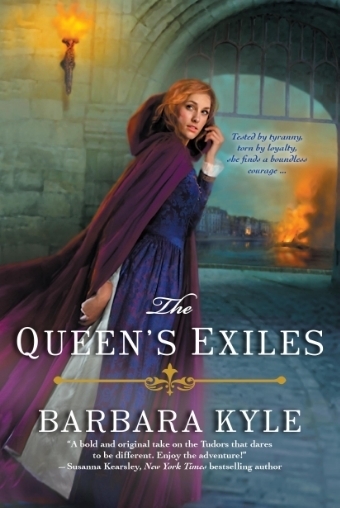
For more about the Thornleigh Saga books, please visit my website: http://www.barbarakyle.com/
***
Published on March 28, 2014 18:10
•
Tags:
elizabeth-i, mary-i, mary-queen-of-scots, thornleigh, thornleighs
Shakespeare, Bloody Mary, and the Bones of Henry VIII
 Research is the lifeblood of our art. Ask any historical novelist and they'll tell you that poring over the letters of our subjects and reading biographies of them and books about their times is a hugely engrossing part of our work. So engrossing, in fact, that I don't think of it anymore as research but The Search.
Research is the lifeblood of our art. Ask any historical novelist and they'll tell you that poring over the letters of our subjects and reading biographies of them and books about their times is a hugely engrossing part of our work. So engrossing, in fact, that I don't think of it anymore as research but The Search.It's like panning for gold. I sit by the riverside day after day sifting through mounds of information sand - solid facts that I need to ground my stories in the truth of the period, but not exactly eye-opening. It's the nuggets I look for. The details that gleam. Facets that will spark my subject to flesh-and-blood life.
Here are a few such nuggets that I alchemized into the life of my books.
 The Queen's Lady features Honor Larke, the (fictional) ward of (the real) Sir Thomas More. More was Henry VIII's chancellor who famously went to the execution block rather than swear the oath that Henry was supreme head of the church in England, a title Henry created so he could divorce Catherine of Aragon and marry Anne Boleyn.
The Queen's Lady features Honor Larke, the (fictional) ward of (the real) Sir Thomas More. More was Henry VIII's chancellor who famously went to the execution block rather than swear the oath that Henry was supreme head of the church in England, a title Henry created so he could divorce Catherine of Aragon and marry Anne Boleyn. My research revealed that in 1517 More was under-sheriff of London, and that on May 1st of that year - "May Day" - the London apprentices rioted and More went with a troop of guards to meet with them. The young men, their torches flaring in the night, were a furious mob, denouncing foreigners for taking their jobs (sound familiar?). They'd gone on a rampage, breaking into foreign-owned shops and assaulting Italians and Flemings in the streets.
The Nugget. Gleaming at me in my research was the fact that, years after More's death, Shakespeare had a hand, along with a couple of other authors, in writing a play called "Sir Thomas More" and in it is a scene of the May Day riot in which More, as undersheriff, addresses the furious apprentices. I went to the British Museum and read the folio. It gave me goose bumps. Shakespeare's brilliance in writing characters glitters in every line he wrote.
More shames the angry young men by asking how would they feel if they were friendless in a faraway county where they would be the foreigners. Would they not hope to be treated with compassion?
For other ruffians, as their fancies wrought,
With self same hand, self reasons, and self right,
Would shark on you, and men like ravenous fishes
Would feed on one another.
He points out an apprentice whose kind Italian master, a foreigner, is giving him a good livelihood and a secure future. With this tolerant rationale More calms the mob. The event is so stirring I used it, reworked to incorporate my created characters, as the opening of The Queen's Lady.
Nugget #2. Sir Thomas More had two young wards, and my research revealed the eye-opening situation of the Tudor Court of Wards. All orphans, male and female, with significant property became wards of the monarch who then sold the wardships to gentlemen who bid for these prizes. Why? Because the guardian got to pocket the rents and revenues of the ward's lands until the ward came of age, at which time the guardian often married the ward to one of his own children, keeping the wealth in the family. I couldn't resist. I created another ward for Sir Thomas More, Honor Larke, to be my novel's heroine. (Read about how the Tudors exploited wardships: https://www.goodreads.com/author_blog....)
 The King's Daughter, features Isabel Thornleigh who joins the uprising led by Sir Thomas Wyatt, a true event in which the rebels sought to unseat Mary I from the throne in the winter of 1554. The only surviving child of Henry VIII and his pious first wife, Catherine of Aragon, Mary was ruled by religious zeal. As queen she oversaw the burning of hundreds of men and women, earning the name her subjects gave her in her lifetime: “Bloody Mary.”
The King's Daughter, features Isabel Thornleigh who joins the uprising led by Sir Thomas Wyatt, a true event in which the rebels sought to unseat Mary I from the throne in the winter of 1554. The only surviving child of Henry VIII and his pious first wife, Catherine of Aragon, Mary was ruled by religious zeal. As queen she oversaw the burning of hundreds of men and women, earning the name her subjects gave her in her lifetime: “Bloody Mary.” Mary was very close to her mother, Catherine, and badly treated by her father. He treated Catherine even worse, sending her off to a damp, drafty house in the fens of Norfolk, far from the royal court where he installed Anne Boleyn as his new queen. Henry forbade Mary to even see the mother she adored. Mary always believed that Catherine died of a broken heart, and she never forgave her father for it.
The Nugget. I read J.J. Scarisbrick's monumental biography, Henry VIII in which he reports that, for decades after Mary’s reign, there was “whispering” that she had dug up the entombed remains of her royal father and burned him as a heretic. Again, I got goose bumps. I can use that, I thought. And I did. The King's Daughter opens on a snowy night at Windsor Castle where, inside St. George’s Chapel, Mary orders the gravedigger to smash the tomb with his pickaxe. And then she burns her hated father's bones.
 The Queen's Captive opens with the true, harrowing moment when Queen Mary has her half-sister, Princess Elizabeth, arrested and sent as a prisoner to the Tower. Mary had caught the rebellion plotters, including Sir Thomas Wyatt, and had begun to execute them. Elizabeth believed she would be the next to be executed. She was twenty years old.
The Queen's Captive opens with the true, harrowing moment when Queen Mary has her half-sister, Princess Elizabeth, arrested and sent as a prisoner to the Tower. Mary had caught the rebellion plotters, including Sir Thomas Wyatt, and had begun to execute them. Elizabeth believed she would be the next to be executed. She was twenty years old. But Elizabeth survived, and at Mary's death four years later she came to the throne. By any measure, Elizabeth's legendary forty-three-year reign was a magnificent success, whereas Mary's five years as queen had been a disaster. She unleashed religious strife, plunged her realm into bankruptcy to finance the wars of her husband, Philip of Spain, and forfeited Calais, England's last precious toehold in Europe.
Yet it is hard not to pity the woman when we consider what she suffered. She adored her husband, who spent only enough time with her to perform his conjugal duty before returning to Spain. A few months later Mary joyfully announced she was pregnant, good news for her people who were anxious to one day have a king. Mary happily passed the next months employing her gentlewomen to sew baby clothes, installing midwives, and sending ecstatic notices to every head of state about the imminent birth.
The nugget. This is a sad one. Mary's time came to deliver . . . and passed. There was no baby. Hers was a phantom pregnancy. Court gossip raged as she remained holed up in her private rooms, and foreign ambassadors wrote home about the situation with increasing astonishment as Mary willed herself to believe she really was pregnant right through the tenth month. (Some modern scholars have attributed her malady to uterine cancer.) This event became a pivotal one in my novel.
Mary's humiliation over her phantom pregnancy coupled with the desertion of her husband broke her in body and spirit. She died with no heir of her body, an abject failure in her own eyes as a wife and as a queen, for she knew that Elizabeth, whom she considered illegitimate, would succeed her. Mary's life was tragic.
 The Queen's Gamble is set in the first year of Elizabeth's reign when her future triumphs were still undreamed of. Quite the contrary: she was just twenty-four and without allies, since all of Catholic Europe considered her a bastard and a heretic. She and her divided council feared that France would invade via Scotland, a country France controlled. People throughout Europe were laying bets that Elizabeth's reign would not last the year.
The Queen's Gamble is set in the first year of Elizabeth's reign when her future triumphs were still undreamed of. Quite the contrary: she was just twenty-four and without allies, since all of Catholic Europe considered her a bastard and a heretic. She and her divided council feared that France would invade via Scotland, a country France controlled. People throughout Europe were laying bets that Elizabeth's reign would not last the year. In my novel Isabel Thornleigh returns from the New World to find French troops posted on the English border, ostensibly to crush Scottish rebels who have banded together under the firebrand preacher John Knox to oust the French. But everyone believes that once the French defeat Knox they will then invade England.
The Nugget. I read in my research that Elizabeth, though desperate for Knox's rebels to win, did not dare openly send them aid for fear it would provoke the very attack from France that she was trying to prevent. So she sent the gold secretly, via a gentleman of her court. It was stolen en route, and Knox had to struggle on with his campaign until Elizabeth eventually sent troops to help him.
But all fiction springs from a "What if?" question in the author's mind, and I took that glinting nugget of the stolen gold and polished it. It became the driving plot element in my novel: Isabel goes north to Scotland with the Queen's gold while war brews all around her.
 Two more books follow in the Thornleigh Saga: Blood Between Queens features Elizabeth I and Mary, Queen of Scots, royal cousins locked in a deadly rivalry for the English crown.
Two more books follow in the Thornleigh Saga: Blood Between Queens features Elizabeth I and Mary, Queen of Scots, royal cousins locked in a deadly rivalry for the English crown.The latest is The Queen's Exiles which will be released 27 May 2014.

The Thornleigh Saga follows a middle-class English family's rise through three turbulent Tudor reigns. For more information about the books please visit http://www.barbarakyle.com/
*****
Published on May 05, 2014 17:16
•
Tags:
bloody-mary, elizabeth-i, henry-viii, queen-mary, shakespeare, the-thornleighs, thornleigh-saga, tudor-england, tudors
Elizabeth and Mary: Leadership Lost and Won
 Should we act from the head or from the heart? In Jane Austen’s terms: from sense or sensibility?
Should we act from the head or from the heart? In Jane Austen’s terms: from sense or sensibility? Two queens epitomize this primal divide.
Elizabeth I of England acted with careful deliberation, keeping her ambitious nobles in line and her kingdom safe from foreign attack during a peaceful reign of over forty years. Her cousin Mary, Queen of Scots followed her passions throughout her seven-year reign, making impetuous decisions that fomented a civil war in which she gambled her kingdom on the battlefield, and lost.
For over four hundred years their story has enthralled the world.
Mary fled to England to escape the Protestant lords who had deposed her, and begged Elizabeth for an army to fight them. But Elizabeth needed Protestant Scotland as a bulwark against possible invasion by Catholic France or Spain, so she kept Mary under house arrest – a captivity, though comfortable, that lasted nineteen years.
While captive, Mary plotted ceaselessly to overthrow Elizabeth and take her crown, and when the last plot almost succeeded, Elizabeth executed her.
The head vs. heart divide marked these two queens’ very different attitudes about leadership. It stemmed partly from their upbringing.

Mary (that's her above) was sent to France at five to join the French king’s family in preparation for marriage to his heir, Francis, and grew up in the most glittering court in Europe, petted and loved by the French royal family. She married Francis when both were in their teens, and when his father died a year later he became king. Queen of France at sixteen, Mary had little to do but please and pamper herself.
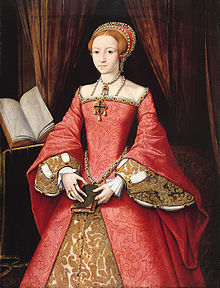
Elizabeth’s childhood, in contrast, was one of uncertainty and fear. (The portrait above shows her in her teens.) Her father, Henry VIII, beheaded her mother, Anne Boleyn, when Elizabeth was three. Then he disinherited Elizabeth. When she was twenty-one her half-sister Mary took the throne and sent Elizabeth to the Tower, where she expected to be executed. But Mary died four years later and Elizabeth became queen. In those perilous years she had learned to watch and wait, and never to act rashly.
It was a lesson Mary, Queen of Scots never learned. When her French royal husband died she returned to Scotland at eighteen to take up her birthright as its queen, and there she fell in love with an English nobleman, Lord Darnley. Despite the disapproval of her councillors, she impulsively married him. Here's Darnley.
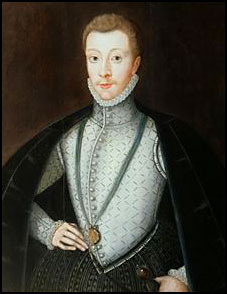
The marriage splintered Mary's nobles into factions, creating a simmering civil war. She bore a son, James, but her marriage quickly soured. She turned to a tough military man, the Earl of Bothwell, and there was gossip they were lovers. Here's Bothwell.
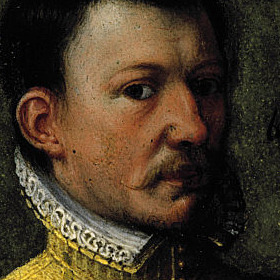
One cold February night the house Darnley was sleeping in was blown up, killing him. Bothwell was accused of Darnley’s murder and stood trial, but was acquitted. Three months later, Mary took Bothwell as her third husband. Her people suspected her of colluding with him to murder Darnley, and turned against her.
Elizabeth, famously, never married. She knew that if she did her husband would be considered king, eclipsing her power and creating warring factions. Her decision to remain single brought her considerable personal anguish. She was heard to say, when Mary’s son was born, that she envied Mary the baby, “while I am barren stock.” But she knew her decision was wise. Elizabeth loved her people, and often said that they were her family. They loved her in return.
Mary is to be pitied, kept captive for nineteen years, then beheaded at Elizabeth’s order. But it was her disastrous, impetuous leadership decisions that led to her downfall.
If peace, prosperity, and international respect are the fruits of successful leadership, the cautious Elizabeth remains one of England’s greatest leaders.
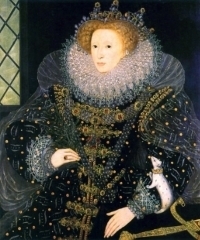
*****
The rivalry between Elizabeth and Mary is featured in my novel Blood Between Queens.

For more about my books please visit http://www.barbarakyle.com/
To receive my newsletters sign up here! http://www.barbarakyle.com/newsletters/
*****
Published on May 14, 2014 05:15
•
Tags:
blood-between-queens, elizabeth-i, historical-fiction, mary-queen-of-scots, tudors
How Fenella Became a Star: the Truth about Writing a Series

Readers love series. It's a benign addiction. We get to know the continuing characters so well we can't wait to find out what happens to them in the next book.
What happens can sometimes surprise the author. The surprise for me was Fenella Doorn.
 Fenella is the heroine of my new historical thriller, The Queen's Exiles. She's a savvy Scottish-born entrepreneur who salvages ships. This is the sixth book in my Thornleigh Saga which follows a middle-class English family's rise through three tumultuous Tudor reigns.
Fenella is the heroine of my new historical thriller, The Queen's Exiles. She's a savvy Scottish-born entrepreneur who salvages ships. This is the sixth book in my Thornleigh Saga which follows a middle-class English family's rise through three tumultuous Tudor reigns.Fenella played a small but crucial role in The Queen's Gamble, and then I kind of forgot about her. She didn't appear in the following book, Blood Between Queens. But when I was planning the story after that Fenella sneaked up me.
She's a determined, passionate, courageous woman, and also rather cheeky - she insisted that I include her in the new story. She reminded me that she had past connections with two exciting men in the series, Adam Thornleigh and Carlos Valverde, which promised some dramatic sparks.
So, I did more than include her in the new book. I made her its star.
That can happen when you write a series - a secondary character can take over. I was glad Fenella did. She offered me an opportunity to create a complex, admirable woman who doesn't fit the ingénue heroine so common in historical fiction.
She's not a young thing; she's thirty. She's not a pampered lady; she rolls up her sleeves running her business of refitting ships. She's attractive but not a smooth-faced beauty; her cheek is scarred from a brute's attack with a bottle years ago. And she's not a virgin; she was once the mistress of the commander of the Edinburgh garrison (he of the bottle attack).
In other words, Fenella is my kind of woman.
But making her the star of the new book in my series meant some serious recalibrating. How could I fit her into the Thornleigh family? Writing a series opens up a vista of opportunities but also a minefield of traps. I'll share a few with you here.
Creating a Series Bible
Before writing full time I enjoyed a twenty-year acting career, and one of the TV series I did was a daytime drama called High Hopes. (That's me on the cover of TV Times, below.) The writers on that series kept a story Bible: a record of the myriad details that had to be consistent from show to show concerning the dozens of characters. It's a wise practice for the writer of a series of novels, too.

My Thornleigh Saga books follow a family for three generations so it's easy to forget facts about a character that were covered three or four books ago. That's why I keep a Bible that tracks the characters' ages, occupations, marriages, love affairs, children, ages of their children, homes, character traits, and physical details like color of hair ... and missing body parts! Richard Thornleigh loses an eye in The Queen's Lady (Book 1) yet in later books I would often start to write things like, "His eyes were drawn to ..." So I keep that Bible near.
Every Book is New
An author can't assume that readers have read the previous books in the series. My agent, Al Zuckerman (in the photo below) always reminds me of this when I send him the outline for a new book in the Thornleigh Saga. "Many readers won't know what these characters have already been through," he wisely says.

So each book has to give some background about what's happened to the main characters in the preceding books, enough to fill in new readers. However, it can't lay on so much back story that it bores readers who have followed all the books. Getting the balance right is tricky.
I like the way episodes in a TV series start with a helpful recap: "Previously on Downton Abbey..." It's perfect: it refreshes the memory of viewers who've seen the previous episodes, and is just enough to tantalize those who haven't and fill them in. I wish I could have a nice announcer give a recap at the beginning of my Thornleigh books! The point is, each book in a series must stand on its own. It has to be a complete and satisfying story for any reader.
Consistency Can Yield Rewards
When I had a brute cut Fenella Doorn's cheek in The Queen's Gamble I never expected Fenella to reappear in a future story. Two books later, when I brought her back in The Queen's Exiles, I could not ignore the fact that she would have a sizable scar on her cheek. So I used that scar to enrich her character.
She had been a beauty at eighteen, relying on men to support her, but when her cut face marred her beauty she realized that it was now up to her to put bread on the table and clothes on her back. I made her aware, even grateful, that the scar freed her from the bonds of beauty; it made her independent. And she became a successful entrepreneur.
Letting Characters Age
It's hard for readers to believe that a hero can fight off bad guys like a young stud if the decades-long timeline of the books he appears in make him, in fact, a senior citizen. J. K Rowling was smart. She let Harry Potter and his friends grow up.
I've enjoyed doing this with my characters. Through six books I've taken Honor Larke from precocious seven-year-old to wise grande dame as Lady Thornleigh. Her step-son Adam Thornleigh's first big role was in The Queen's Captive where he was an impetuous seafaring adventurer, but by the time of The Queen's Exiles Adam has become a mature man, a loyal champion of his friend Queen Elizabeth. He has been through a loveless marriage, adores his two children, and falls hard for Fenella.
I'm grateful that Fenella Doorn insisted I feature her in The Queen's Exiles. (By the way, that's her on the cover.) The book has been out for just a week and already I'm hearing from readers that they love her.
Fenella is a star.
"Riveting Tudor drama in the bestselling vein of Philippa Gregory." - USA Today

***
For more about my books, or to sign up for my Newsletter, please visit my website: http://www.barbarakyle.com/
Published on June 05, 2014 06:56
•
Tags:
elizabeth-i, the-queen-s-exiles, thornleigh-saga, tudor-england, tudors
Join Me On My Book Tour
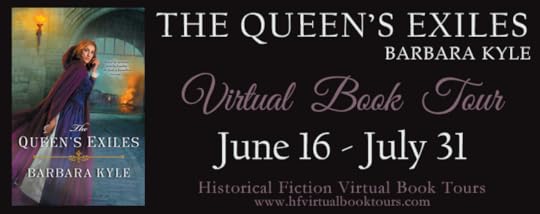
The virtual tour with my new historical thriller, The Queen's Exiles, kicks off today!
Join me for interviews, my posts on the great hosting blogs, and a bunch of giveaways with lots of chances to win a signed copy of The Queen's Exiles.
Details of the tour schedule are here: http://hfvirtualbooktours.com/thequee...
Hope to see you on the tour!
*****
If you'd like to receive my Newsletters you can sign up here: http://www.barbarakyle.com/newsletters/
Published on June 16, 2014 07:31
•
Tags:
elizabeth-i, giveaway, historical-fiction, the-queen-s-exiles, thornleigh-saga, tudors
My Kind of Woman

The "star" of my new novel, The Queen's Exiles is Scottish-born Fenella Doorn. (That's her on the cover.) Of all the characters I've created in my six Thornleigh Saga novels, she's one of my favorites.
Fenella is a savvy entrepreneur who salvages ships. To me, she's a true hero. Yet, for a long time, I didn't see her potential. She almost got elbowed into obscurity as a mere "bit player."
Fenella played a small but crucial role in The Queen's Gamble, and then I kind of forgot about her. She didn't appear in the next book, but when I was planning the story after that she sneaked up me.
She's a determined, passionate, courageous woman, and rather cheeky—she insisted that I include her in the new story. She reminded me that she had past connections with two exciting men in the series, Adam Thornleigh and Carlos Valverde, which promised some dramatic sparks. So, I did more than include her in the new book, I made her its star.
Fenella offered me an opportunity to create a complex, admirable woman who doesn't fit the ingénue heroine so common in historical fiction.
She's not a young thing; she's thirty. She's not a pampered lady; she rolls up her sleeves running her business of refitting ships. She's attractive but not a smooth-faced beauty; her cheek is scarred from a brute's attack with a bottle years ago. And she's not a virgin; she was once the mistress of the commander of the Edinburgh garrison (he of the bottle attack).
She had been a beauty at eighteen, relying on men to support her, but when her cut face marred her attractiveness she realized that it was now up to her to put bread on the table and clothes on her back. I made her aware, even grateful, that the scar freed her from the bonds of beauty; it made her independent. And she became a successful entrepreneur. In other words, Fenella is my kind of woman.
I hope you'll enjoy her story.
"Riveting Tudor drama" - USA Today
"An epic tale of patriotism and treason, political upheaval and oppression, familial love and the ties that bind" - Let Them Read Books blog
For more about my books please visit my website: http://www.barbarakyle.com/

Published on July 01, 2014 06:42
•
Tags:
elizabeth-i, historical-fiction, historical-novel, the-queen-s-exiles, thornleigh-saga, tudors



